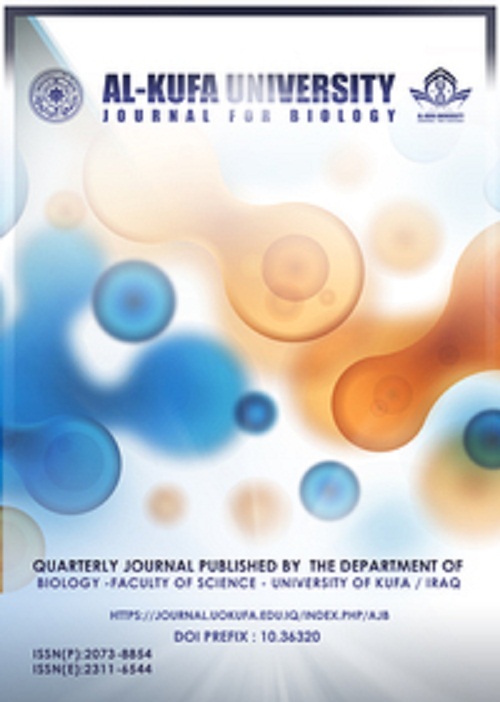Measuring the concentrations of some gaseous and particulate air pollutants in the indoor environment of homes (Iraq - Kufa city, a case study)
DOI:
https://doi.org/10.36320/ajb/v15.i3.13564Keywords:
pollutants, Gaseous, Particulate Air PollutantsAbstract
The purpose of the study is to detect the concentration of some gaseous and particulate air pollutants in the indoor air of the city of Kufa. The pollutants include (CO, CO2, SO2, NO2, PM10, PM2.5). The concentrations of these pollutants were measured during the period from July 2022 to January 2023 at seventeen stations in the city of Kufa. From each station, three sites (houses) were selected, making (51 dwellings). The study showed the role of some climate elements, such as temperature and humidity, as well as the role of the size of the house and the type of building, as well as the role of house uses such as cleaning and cooking materials in influencing the increase in the concentration of air pollutants. The results showed that there was a variation in the levels of concentrations of air pollutants, and their variation between the months of July and January.
Downloads
References
Chaloulakou, A., Mavroidis, I. (2012). Comparison of indoor and outdoor concentrations of CO at a public school. Evaluation of an indoor air quality model. Atmospheric Environment 36, 1769–1781. DOI: https://doi.org/10.1016/S1352-2310(02)00151-6
Rosemary Jane Day). 2004(. Perceptions of Air Pollution and Health in Social and Geographical Contexts, Doctoral Thesis, University of London, University College London, Department of Geography.
Shivam Gupta, Spatial Modelling of Air Pollution for open Smart Cities,doctoral thesis of Natural Sciences, Faculty of Mathematics and Natural Sciences, University Munster, 2018.
Yan, Y.; Bai, Z. Research Advances in Exposure to Ambient Particulate Matter and Health Effects. Asian J. Ecotoxicol. 2012, 7, 123-132.
Environmental Protection Agency (EPA). (2016). Introduction to Indoor Air Quality. Retrieved July 20, 2016, from EPA: https://www.epa.gov/indoorair- qualityiaq/introduction-indoor-air-quality.
Klepeis, N., Nelson, W., Ott, W., Robinson, J., Tsang, A., Switzer, P., Behar, J., Hern, S., Engelmann, W. (2010). The National Human Activity Pattern Survey (Nhaps): A Resource For Assessing Exposure To Environmental Pollutants. Journal Of Exposure Analysis and Environmental Epidemiology 11:231-252. DOI: https://doi.org/10.1038/sj.jea.7500165
Niklas Berglind .(2017). Cardiovascular and Respiratory Effects of Air Pollution,doctoral thesis, The Institute of Environmental Medicine, Karolinska Institutet.
Environmental Protection Agency (EPA). (2016). Volatile organic compounds' impact on indoor air quality. Retrieved January 20, 2017, from EPA :https://www.epa.gov/indoor-air-quality-iaq/volatile-organic-compounds-impactindoor-air-quality.
Yin, W.J.; Peng, X.W.; Song, S.Z. (2012). Air Pollution and the Cerebro Cardio-vascular Diseases Mortality of Population in Guangzhoura Time-series Analysis. J. Environ. Health, 29, 521-525.
Environmental Protection Agency (EPA). (2016). Volatile organic compounds' impact on indoor air quality. Retrieved January 20, 2017, from EPA :https://www.epa.gov/indoor-air-quality-iaq/volatile-organic-compounds-impactindoor-air-quality.
Nilsson, E. (2003). Achieving the desired indoor climate. Energy efficiency aspects of system design. Denmark: Student literature, Lund.
Cociorva, S., Iftene, A. (2017). Indoor air quality evaluation in intelligent building. Energy Procedia 112:261 – 268. DOI: https://doi.org/10.1016/j.egypro.2017.03.1095
Chengappa. C., Edwards,E., Bajpai, R., Shields, K., N and Smith, K. R. (2007). Impact of improved cook stoves on indoor air quality in the Bundelkhand region in India. Energy for Sustainable Development 11(2):33-44. DOI: https://doi.org/10.1016/S0973-0826(08)60398-1
Ballester, F.; Tenias, J.M.; Pérezhoyos, S. (2001). Air pollution and emergency hospital admissions for cardiovascular diseases in Valencia, Spain. J. Epidemiol. Community Health, 55, 57-65. [CrossRef] [PubMed]. DOI: https://doi.org/10.1136/jech.55.1.57
Escobedo, L., Champion, W., Li, N., Montoya, L. (2014). Indoor air quality in Latino homes in Boulder, Colorado. Atmospheric Environment 92:69-75. DOI: https://doi.org/10.1016/j.atmosenv.2014.03.043
DOSH, (2010) . Industry code of practice on indoor air quality, Malaysia.
Hazyuk, I., Ghiaus, Ch., Penhouet, D. (2012). Optimal temperature control of intermittently heated buildings using model predictive control: part II control algorithm. Buildings Environment 51:388–394. DOI: https://doi.org/10.1016/j.buildenv.2011.11.008
Gilbert, D., He, C., Morawska, L. (2005). Indoor exposure to sub micrometer particles and PM2.5 in residential houses in Brisbane, Australia. Proceedings of Indoor Air, China, Beijing.
Mukherjee, Arideep and Agrawal, Madhoolika.( 2017 ). A Global Perspective of Fine Particulate Matter Pollution and Health Effects, Environmental Contamination and Toxicology, 3. DOI: https://doi.org/10.1007/398_2017_3
Jia C, Batterman S. A critical review of naphthalene sources and exposures relevant to indoor and outdoor air. International journal of environmental research and public health. 2010 Jul;7(7):2903-39. DOI: https://doi.org/10.3390/ijerph7072903
Brasche, S., Bischof, W. (2005). Daily time spent indoors in German homes–baseline data for the assessment of indoor exposure of German occupants. International Journal of Hygiene and Environment Health 208:247–253. DOI: https://doi.org/10.1016/j.ijheh.2005.03.003
Leech, J.A., Nelson, W.C., Burnett, R.T., Aaron, S., Raizenne, M.E. (2002). It's about time: a comparison of Canadian and American time–activity patterns. Journal of Exposure Analysis and Environmental Epidemiology 12:427-432. DOI: https://doi.org/10.1038/sj.jea.7500244
Luecken, D.J., Hutzell, W.T., Strum, M.L. and Pouliot, G.A. (2012). Regional Sources of Atmospheric Formaldehyde and Acetaldehyde, and Implications for Atmospheric Modeling. Atmospheric Environment 47: 477–490. DOI: https://doi.org/10.1016/j.atmosenv.2011.10.005
Gilbert, D., He, C., Morawska, L. (2005). Indoor exposure to sub micrometer particles and PM2.5 in residentialn houses in Brisbane, Australia. Proceedings of Indoor Air, China, Beijing.
Víctor Manuel Valverde Morales, 2016. Characterization of atmospheric pollution dynamics in Spain by means of air quality modelling, Ph.D. Thesis, Universitat Politecnica De Catalunya, pl.
Downloads
Published
How to Cite
Issue
Section
License
Copyright (c) 2023 Baneen Allawi Khadhr, Faris J. Alduhaidahawi

This work is licensed under a Creative Commons Attribution 4.0 International License.
which allows users to copy, create extracts, abstracts, and new works from the Article, alter and revise the Article, and make commercial use of the Article (including reuse and/or resale of the Article by commercial entities), provided the user gives appropriate credit (with a link to the formal publication through the relevant DOI), provides a link to the license, indicates if changes were made and the licensor is not represented as endorsing the use made of the work.












